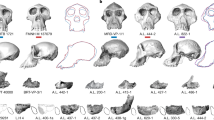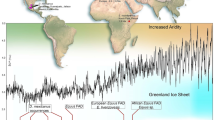Abstract
The origin of Australopithecus, the genus widely interpreted as ancestral to Homo, is a central problem in human evolutionary studies. Australopithecus species differ markedly from extant African apes and candidate ancestral hominids such as Ardipithecus, Orrorin and Sahelanthropus. The earliest described Australopithecus species is Au. anamensis, the probable chronospecies ancestor of Au. afarensis. Here we describe newly discovered fossils from the Middle Awash study area that extend the known Au. anamensis range into northeastern Ethiopia. The new fossils are from chronometrically controlled stratigraphic sequences and date to about 4.1–4.2 million years ago. They include diagnostic craniodental remains, the largest hominid canine yet recovered, and the earliest Australopithecus femur. These new fossils are sampled from a woodland context. Temporal and anatomical intermediacy between Ar. ramidus and Au. afarensis suggest a relatively rapid shift from Ardipithecus to Australopithecus in this region of Africa, involving either replacement or accelerated phyletic evolution.
This is a preview of subscription content, access via your institution
Access options
Subscribe to this journal
Receive 51 print issues and online access
We are sorry, but there is no personal subscription option available for your country.
Buy this article
- Purchase on SpringerLink
- Instant access to full article PDF
Prices may be subject to local taxes which are calculated during checkout




Similar content being viewed by others
References
Asfaw, B. The Belohdelie frontal: New evidence of early hominid cranial morphology from the Afar of Ethiopia. J. Hum. Evol. 16, 611–624 (1987)
White, T. D., Suwa, G. & Asfaw, B. Australopithecus ramidus, a new species of early hominid from Aramis, Ethiopia. Nature 371, 306–312 (1994)
Haile-Selassie, Y. Late Miocene hominids from the Middle Awash, Ethiopia. Nature 412, 178–181 (2001)
White, T. D. in The Primate Fossil Record (ed. Hartwig, W.) 407–417 (Cambridge Univ. Press, Cambridge, 2002)
Leakey, M. G., Feibel, C. S., McDougall, I. & Walker, A. New four-million-year-old hominid species from Kanapoi and Allia Bay, Kenya. Nature 376, 565–571 (1995)
Leakey, M. G., Feibel, C. S., McDougall, I., Ward, C. & Walker, A. New specimens and confirmation of an early age for Australopithecus anamensis. Nature 393, 62–66 (1998)
Ward, C., Leakey, M. & Walker, A. C. The new hominid species Australopithecus anamensis. Evol. Anthropol. 7, 197–205 (1999)
Ward, C., Leakey, M. G. & Walker, A. Morphology of Australopithecus anamensis from Kanapoi and Allia Bay, Kenya. J. Hum. Evol. 41, 255–368 (2001)
Haile-Selassie, Y., Suwa, G. & White, T. D. Late Miocene teeth from Middle Awash, Ethiopia, and early hominid dental evolution. Science 303, 1503–1505 (2004)
Senut, B. et al. First hominid from the Miocene (Lukeino Formation, Kenya). C.R. Acad. Sci. (Paris) 332, 134–144 (2000)
Pickford, M., Senut, B., Grommery, D. & Treil, J. Bipedalism in Orrorin tugenensis revealed by its femora. C.R. Palevol 1, 191–203 (2002)
Brunet, M. et al. A new hominid from the upper Miocene of Chad, central Africa. Nature 418, 145–151 (2002)
Ohman, J., Lovejoy, C. O. & White, T. D. Questions about Orrorin femur. Science 307, 845b (2005)
White, T. D. Early hominid femora: The inside story. Palevol (in the press)
White, T. D. in Paleoclimate and Evolution, with Emphasis on Human Origins (eds Vrba, E., Denton, G., Partridge, T. & Burkle, L.) 369–384 (Yale Univ. Press, New Haven, 1995)
Renne, P. R., WoldeGabriel, G., Hart, W. K., Heiken, G. & White, T. D. Chronostratigraphy of the Miocene-Pliocene Sagantole Formation, Middle Awash Valley, Afar Rift, Ethiopia. Geol. Soc. Am. Bull. 111, 869–885 (1999)
Renne, P. R. et al. Intercalibration of standards, absolute ages and uncertainties in 40Ar/39Ar dating. Chem. Geol. Isot. Geosci. Sect. 145, 117–152 (1998)
Hlusko, L. J. A new large Pliocene colobine species (Mammalia: Primates) from Asa Issie, Ethiopia. Geobios 39, 57–69 (2006)
Cerling, T. E., Bowman, J. R. & O'Neil, J. R. An isotopic study of a fluvial-lacustrine sequence: The Plio-Pleistocene Koobi Fora sequence, East Africa. Palaeogeogr. Palaeoclimatol. Palaeoecol. 63, 335–356 (1988)
Levin, N. E., Quade, J., Simpson, S. W., Semaw, S. & Rogers, M. Isotopic evidence for Plio-Pleistocene environmental change at Gona, Ethiopia. Earth Planet. Sci. Lett. 219, 93–110 (2004)
WoldeGabriel, G. et al. Geology and palaeontology of the Late Miocene Middle Awash Valley, Afar Rift, Ethiopia. Nature 412, 175–178 (2001)
Haile-Selassie, Y. et al. Mio-Pliocene mammals from the Middle Awash, Ethiopia. Geobios 37, 536–552 (2004)
Wynn, J. G. Paleosols, stable carbon isotopes, and paleoenvironmental interpretation of Kanapoi, Northern Kenya. J. Hum. Evol. 39, 411–432 (2000)
Flessa, K. et al. The Geological Record of Ecological Dynamics: Understanding the Biotic Effects of Future Environmental Change (National Academy of Sciences, Washington, 2005)
Kono, R. T. Molar enamel thickness and distribution patterns in extant great apes and humans: New insights based on a 3-dimensional whole crown perspective. Anthropol. Sci. 112, 121–146 (2004)
Suwa, G. & Kono, R. A micro-CT based study of linear enamel thickness in the mesial cusp section of human molars: Reevaluation of methodology and assessment of within-tooth, serial, and individual variation. Anthropol. Sci. 113, 273–289 (2005)
Coffing, K., Feibel, C., Leakey, M. & Walker, A. Four-million-year-old hominids from east Lake Turkana, Kenya. Am. J. Phys. Anthropol. 93, 55–65 (1994)
Schoeninger, J. J., Reeser, H. & Hallin, K. Paleoenvironment of Australopithecus anamensis at Allia Bay, East Turkana, Kenya: Evidence from mammalian herbivore enamel stable isotopes. J. Anthropol. Archaeol. 22, 200–207 (2003)
Semaw, S. et al. Early Pliocene hominids from Gona, Ethiopia. Nature 433, 301–305 (2005)
Wood, B. & Richmond, B. G. Human evolution: Taxonomy and paleobiology. J. Anat. (Lond.) 196, 19–60 (2000)
Kappelman, J. et al. Age of Australopithecus afarensis from Fejej, Ethiopia. J. Hum. Evol. 30, 139–146 (1996)
Haile-Selassie, Y. & Asfaw, B. A newly discovered early Pliocene hominid-bearing paleontological site in the Mulu Basin, Ethiopia. Am. J. Phys. Anthropol. 30 (suppl.), 170 (2000)
Wood, B. The oldest hominid yet. Nature 371, 280–281 (1994)
Stern, J. T. & Susman, R. L. The locomotor anatomy of Australopithecus afarensis. Am. J. Phys. Anthropol. 60, 279–317 (1983)
Gould, S. J. The Structure of Evolutionary Theory (Belknap, Harvard, Cambridge, 2002)
Wagner, P. The quality of the fossil record and the accuracy of phylogenetic inferences about sampling and diversity. Syst. Biol. 49, 65–86 (2000)
Hlusko, L. J., Suwa, G., Kono, R. T. & Mahaney, M. C. Genetics and the evolution of primate enamel thickness: A baboon model. Am. J. Phys. Anthropol. 124, 223–233 (2004)
Malmgren, B. A., Berggren, W. A. & Lohman, G. P. Evidence for punctuated gradualism in the Late Neogene Globorotalia tumida lineage of planktonic foraminifera. Paleobiology 9, 377–389 (1983)
McKinney, M. L. & McNamara, K. J. Heterochrony: The Evolution of Ontogeny (Plenum, New York, 1991)
Stanley, S. M. Macroevolution: Pattern and Process (W. H. Freeman, San Francisco, 1979)
Teaford, M. F. & Ungar, P. S. Diet and the evolution of the earliest human ancestors. Proc. Natl Acad. Sci. USA 97, 13506–13511 (2000)
Macho, G. A., Shimizu, D., Jiang, Y. & Spears, I. R. Australopithecus anamensis: A finite-element approach to studying the functional adaptations of extinct hominins. Anat. Rec. 283A, 310–318 (2005)
Kingston, J. D., Marino, B. D. & Hill, A. Isotopic evidence for Neogene hominid paleoenvironments in the Kenya Rift Valley. Science 264, 955–959 (1994)
DeMenocal, P. African climate change and faunal evolution during the Pliocene-Pleistocene. Earth Planet. Sci. Lett. 220, 3–24 (2004)
Vrba, E. S. Mass turnover and heterochrony events in response to physical change. Paleobiology 31, 157–174 (2005)
Cande, S. C. & Kent, D. V. Revised calibration of the geomagnetic polarity timescale for the Late Cretaceous and Cenozoic. J. Geophys. Res. 100, 6093–6095 (1995)
Hall, C. M., Walter, R. C., Westgate, J. A. & York, D. Geochronology, stratigraphy and geochemistry of Cindery Tuff in Pliocene hominid-bearing sediments of the Middle Awash, Ethiopia. Nature 308, 26–31 (1984)
White, T. D. et al. New discoveries of Australopithecus at Maka, Ethiopia. Nature 366, 261–265 (1993)
Hart, W. K., Walter, R. C. & WoldeGabriel, G. Tephra sources and correlations in Ethiopia: Application of elemental and neodymium isotope data. Quatern. Int. 13/14, 77–86 (1992)
Haileab, B. & Brown, F. H. Turkana Basin–Middle Awash Valley correlations and the age of the Sagantole and Hadar Formations. J. Hum. Evol. 22, 453–468 (1992)
Acknowledgements
We thank the National Science Foundation (including the Revealing Hominid Origins Initiative/HOMINID program), the Institute of Geophysics and Planetary Physics of the University of California at Los Alamos National Laboratory (LANL), the Japan Society for the Promotion of Science, the Fondation Singer-Polignac, and the Philip and Elaina Hampton Fund for Faculty International Initiatives at Miami University for financial support of field and laboratory research. The Earth and Environmental Sciences Division Electron Microprobe laboratory at LANL assisted with access and use. We thank A. Ademassu, W. Amerga, A. Amzaye, A. Asfaw, G. Assefa, F. Bibi, M. Black, D. Brill, K. Brudvik, M. Chalachew, M. Chubachi, W. Demisse (in memoriam), N. Eldredge, H. Elema, E. Güleç, M. Haydera, R. Jabbour, A.-R. Jaouni, K. Kairento, F. Kaya, K. Kimeu, B. Kyongo, D. Kubo, W. Liu, S. Mahieu, W. Mangao, M. McCollum, E. Mekonnen, W. Mihel, L. Morgan, C. Pehlevan, P. Reno, G. Richards, B. Rosenman, M. Serrat, A. Shabel, L. Smeenk, B. Tegengne, A. Terrazas and S. Yoseph for fieldwork, laboratory work and discussion, and M. Leakey for collections access. We thank the Ministry of Youth, Sports and Culture, the Authority for Research and Conservation of the Cultural Heritage, and the National Museum of Ethiopia for permissions and facilitation. We also thank the Afar Regional Government, the Afar people of the Middle Awash, and many others for contributing directly to the research efforts.
Author information
Authors and Affiliations
Corresponding author
Ethics declarations
Competing interests
Reprints and permissions information is available at npg.nature.com/reprintsandpermissions. The authors declare no competing financial interests.
Supplementary information
Supplementary Discussion 1
Dental metric comparisons. (PDF 734 kb)
Supplementary Discussion 2
Enamel thickness measurements. (PDF 47 kb)
Supplementary Discussion 3
Cladistic relationships. (PDF 652 kb)
Supplementary Figure 1
ASI paleosol carbonates. (PDF 154 kb)
Supplementary Figure 2
Comparative dental morphology. (PDF 1062 kb)
Supplementary Figure 3
Argon-argon results. (PDF 131 kb)
Supplementary Table 1
Hominid fossils. (PDF 42 kb)
Supplementary Table 2
Isotopic composition of paleosol carbonates. (PDF 21 kb)
Supplementary Table 3
Faunal list. (PDF 52 kb)
Supplementary Table 4
Radioisotopic dating results. (PDF 30 kb)
Rights and permissions
About this article
Cite this article
White, T., WoldeGabriel, G., Asfaw, B. et al. Asa Issie, Aramis and the origin of Australopithecus. Nature 440, 883–889 (2006). https://doi.org/10.1038/nature04629
Received:
Accepted:
Issue Date:
DOI: https://doi.org/10.1038/nature04629
This article is cited by
-
Reappraising the palaeobiology of Australopithecus
Nature (2023)
-
A 3.8-million-year-old hominin cranium from Woranso-Mille, Ethiopia
Nature (2019)
-
Age and context of mid-Pliocene hominin cranium from Woranso-Mille, Ethiopia
Nature (2019)
-
Food mechanical properties and isotopic signatures in forest versus savannah dwelling eastern chimpanzees
Communications Biology (2018)
-
Estimating hominid life history: the critical interbirth interval
Population Ecology (2018)



